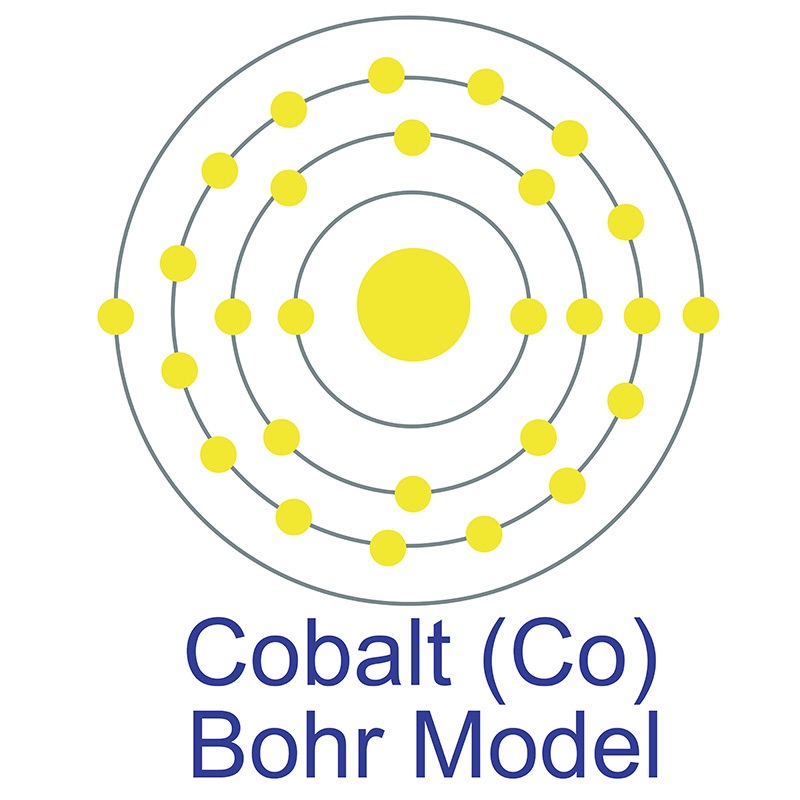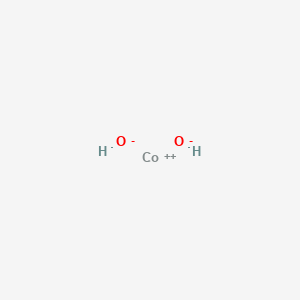SECTION 1. IDENTIFICATION
Product Name: Cobalt Hydroxide
Product Number: All applicable American Elements product codes, e.g. CO-OH-02
, CO-OH-025
, CO-OH-03
, CO-OH-035
, CO-OH-04
, CO-OH-TG
CAS #: 21041-93-0
Relevant identified uses of the substance: Scientific research and development
Supplier details:
American Elements
10884 Weyburn Ave.
Los Angeles, CA 90024
Tel: +1 310-208-0551
Fax: +1 310-208-0351
Emergency telephone number:
Domestic, North America: +1 800-424-9300
International: +1 703-527-3887
SECTION 2. HAZARDS IDENTIFICATION
Classification
This chemical is considered hazardous by the 2012 OSHA Hazard Communication Standard (29 CFR 1910.1200)
Acute oral toxicity Category 4
Acute Inhalation Toxicity - Dusts and Mists Category 4
Serious Eye Damage/Eye Irritation Category 2
Respiratory Sensitization Category 1
Skin Sensitization Category 1
Carcinogenicity Category 1B
Label Elements
Signal Word
Danger
Hazard Statements
May cause an allergic skin reaction
Causes serious eye irritation
May cause allergy or asthma symptoms or breathing difficulties if inhaled
May cause cancer
Harmful if swallowed or if inhaled


Precautionary Statements
Prevention
Obtain special instructions before use
Do not handle until all safety precautions have been read and understood
Use personal protective equipment as required
Wash face, hands and any exposed skin thoroughly after handling
Do not eat, drink or smoke when using this product
Avoid breathing dust/fume/gas/mist/vapors/spray
Use only outdoors or in a well-ventilated area
In case of inadequate ventilation wear respiratory protection
Contaminated work clothing should not be allowed out of the workplace
Wear protective gloves/protective clothing/eye protection/face protection
Response
IF exposed or concerned: Get medical attention/advice
Inhalation
IF INHALED: Remove victim to fresh air and keep at rest in a position comfortable for breathing
If experiencing respiratory symptoms: Call a POISON CENTER or doctor/physician
Skin
IF ON SKIN: Wash with plenty of soap and water
If skin irritation or rash occurs: Get medical advice/attention
Wash contaminated clothing before reuse
Eyes
IF IN EYES: Rinse cautiously with water for several minutes. Remove contact lenses, if present and easy to do. ContinuerinsingIf eye irritation persists: Get medical advice/attention
Ingestion
IF SWALLOWED: Call a POISON CENTER or doctor/physician if you feel unwell
Rinse mouth
Storage
Store locked up
Disposal
Dispose of contents/container to an approved waste disposal plant
Hazards not otherwise classified (HNOC)
Very toxic to aquatic life with long lasting effects
SECTION 3. COMPOSITION/INFORMATION ON INGREDIENTS
Component CAS-No Weight %
Cobalt hydroxide 21041-93-0 >95
SECTION 4. FIRST AID MEASURES
General Advice
If symptoms persist, call a physician.
Eye Contact
Rinse immediately with plenty of water, also under the eyelids, for at least 15 minutes. Get medical attention.
Skin Contact
Wash off immediately with plenty of water for at least 15 minutes. If skin irritation persists,call a physician.
Inhalation
Remove to fresh air. If not breathing, give artificial respiration. Get medical attention if
symptoms occur.
Ingestion
Clean mouth with water and drink afterwards plenty of water. Get medical attention if
symptoms occur.
Most important symptoms and effects
May cause allergy or asthma symptoms or breathing difficulties if inhaled. May cause allergic skin reaction. Symptoms of allergic reaction may include rash, itching, swelling,
trouble breathing, tingling of the hands and feet, dizziness, lightheadedness, chest pain, muscle pain or flushing
Notes to Physician Treat symptomatically
SECTION 5. FIREFIGHTING MEASURES
Suitable Extinguishing Media Water spray, carbon dioxide (CO2), dry chemical, alcohol-resistant foam. Unsuitable Extinguishing Media No information available
Flash Point No information available
Method - No information available
Autoignition Temperature Not applicable
Explosion Limits
Upper No data available
Lower No data available
Sensitivity to Mechanical Impact No information available
Sensitivity to Static Discharge No information available
Specific Hazards Arising from the Chemical
Do not allow run-off from fire-fighting to enter drains or water courses. Thermal decomposition can lead to release of irritatinggases and vapors. Hazardous Combustion Products
Cobalt oxides.
Protective Equipment and Precautions for Firefighters
As in any fire, wear self-contained breathing apparatus pressure-demand, MSHA/NIOSH (approved or equivalent) and full protective gear.
NFPA
Health 2
Flammability 0
Instability 0
Physical hazards N/A
SECTION 6. ACCIDENTAL RELEASE MEASURES
Personal Precautions
Use personal protective equipment as required. Ensure adequate ventilation. Avoid dust
formation.
Environmental Precautions
Do not flush into surface water or sanitary sewer system. Do not allow material tocontaminate ground water system. Prevent product from entering drains. Local authorities should be advised if significant spillages cannot be contained. Should not be releasedintothe environment.
Methods for Containment and Clean Up
Sweep up and shovel into suitable containers for disposal. Keep in suitable, closedcontainers for disposal.
SECTION 7. HANDLING AND STORAGE
Handling
Wear personal protective equipment/face protection. Ensure adequate ventilation. Do not get in eyes, on skin, or on clothing. Avoid ingestion and inhalation. Avoid dust formation.
Storage
Keep containers tightly closed in a dry, cool and well-ventilated place.
SECTION 8. EXPOSURE CONTROLS/PERSONAL PROTECTION
ACGIH - American Conference of Governmental Industrial Hygienists
Engineering Measures Ensure that eyewash stations and safety showers are close to the work station location. Ensure adequate ventilation, especially in confined areas.
Personal Protective Equipment
Eye/face Protection
Wear appropriate protective eyeglasses or chemical safety goggles as describedbyOSHA's eye and face protection regulations in 29 CFR 1910.133 or European StandardEN166.
Skin and body protection
Wear appropriate protective gloves and clothing to prevent skin exposure.
Respiratory Protection Follow the OSHA respirator regulations found in 29 CFR 1910.134 or EuropeanStandardEN 149. Use a NIOSH/MSHA or European Standard EN 149 approved respirator if exposure limits are exceeded or if irritation or other symptoms are experienced.
Hygiene Measures
Handle in accordance with good industrial hygiene and safety practice
SECTION 9. PHYSICAL AND CHEMICAL PROPERTIES
Physical State Powder Solid
Appearance Pink
Odor Odorless
Odor Threshold No information available
pH No information available
Melting Point/Range No data available
Boiling Point/Range No information available
Flash Point No information available
Evaporation Rate Not applicable
Flammability (solid,gas) No information available
Flammability or explosive limits
Upper No data available
Lower No data available
Vapor Pressure No information available
Vapor Density Not applicable
Specific Gravity No information available
Solubility No information available
Partition coefficient; n-octanol/water No data available
Autoignition Temperature Not applicable
Decomposition Temperature No information available
Viscosity Not applicable
Molecular Formula Co H2 O2
Molecular Weight 92.95
SECTION 10. STABILITY AND REACTIVITY
Reactive Hazard None known, based on information available
Stability Stable under normal conditions. Conditions to Avoid Incompatible products. Excess heat. Avoid dust formation.
Incompatible Materials Strong oxidizing agents
Hazardous Decomposition Products Cobalt oxides
Hazardous Polymerization Hazardous polymerization does not occur. Hazardous Reactions None under normal processing
SECTION 11. TOXICOLOGICAL INFORMATION
Acute Toxicity
Product Information
Component Information
Toxicologically Synergistic
Products
No information available
Delayed and immediate effects as well as chronic effects from short and long-term exposure
Irritation No information available
Sensitization No information available
Mutagenic Effects No information available
Reproductive Effects No information available. Developmental Effects No information available. Teratogenicity No information available. STOT - single exposure None known
STOT - repeated exposure None known
Aspiration hazard No information available
Symptoms / effects,both acute and
delayed
Symptoms of allergic reaction may include rash, itching, swelling, trouble breathing, tinglingof the hands and feet, dizziness, lightheadedness, chest pain, muscle pain or flushingEndocrine Disruptor Information No information available
SECTION 12. ECOLOGICAL INFORMATION
Ecotoxicity
The product contains following substances which are hazardous for the environment. Very toxic to aquatic organisms, maycauselong-term adverse effects in the aquatic environment. May cause long-term adverse effects in the environment. Do not allow material to contaminate ground water system.
Persistence and Degradability May persist
Bioaccumulation/ Accumulation No information available.
Mobility No information available
SECTION 13. DISPOSAL CONSIDERATIONS
Waste Disposal Methods
Chemical waste generators must determine whether a discarded chemical is classifiedasahazardous waste. Chemical waste generators must also consult local, regional, andnational hazardous waste regulations to ensure complete and accurate classification.
SECTION 14. TRANSPORT INFORMATION
DOT
UN-No UN3077
Proper Shipping Name Environmentally hazardous substances, solid, n.o.s. Technical Name (COBALT(II) HYDROXIDE)
Hazard Class 9
Packing Group III
TDG
UN-No UN3077
Proper Shipping Name Environmentally hazardous substances, solid, n.o.s. Hazard Class 9
Packing Group III
IATA
UN-No UN3077
Proper Shipping Name Environmentally hazardous substances, solid, n.o.s. Hazard Class 9
Packing Group III
IMDG/IMO
UN-No UN3077
Proper Shipping Name Environmentally hazardous substances, solid, n.o.s. Hazard Class 9
Packing Group III
SECTION 15. REGULATORY INFORMATION
U.S. Federal Regulations
SARA 313
Component CAS-No Weight % SARA 313 - Threshold Values % Cobalt hydroxide 21041-93-0 >95 0.1 SARA 311/312 Hazard Categories See section 2 for more information
CWA (Clean Water Act) Not applicable
Clean Air Act
Component HAPS Data Class 1 Ozone Depletors Class 2 Ozone Depletors Cobalt hydroxide X - OSHA - Occupational Safety and
Health Administration
Not applicable
CERCLA Not applicable
California Proposition 65 This product does not contain any Proposition 65 chemicals. U.S. State Right-to-Know
Regulations
Component Massachusetts New Jersey Pennsylvania Illinois Rhode Island Cobalt hydroxide - X X X - U.S. Department of Transportation
Reportable Quantity (RQ): N
DOT Marine Pollutant N
DOT Severe Marine Pollutant N
U.S. Department of Homeland
Security
This product does not contain any DHS chemicals. Other International Regulations
Mexico - Grade No information available
SECTION 16. OTHER INFORMATION
Safety Data Sheet according to Regulation (EC) No. 1907/2006 (REACH). The above information is believed to be correct but does not purport to be all inclusive and shall be used only as a guide. The information in this document is based on the present state of our knowledge and is applicable to the product with regard to appropriate safety precautions. It does not represent any guarantee of the properties of the product. American Elements shall not be held liable for any damage resulting from handling or from contact with the above product. See reverse side of invoice or packing slip for additional terms and conditions of sale. COPYRIGHT 1997-2022 AMERICAN ELEMENTS. LICENSED GRANTED TO MAKE UNLIMITED PAPER COPIES FOR INTERNAL USE ONLY.

 The number of electrons in each of cobalt's shells is 2, 8, 15, 2 and its electron configuration is [Ar]3d7 4s2. The cobalt atom has a radius of 125 pm and a Van der Waals radius of 192 pm. Cobalt was first discovered by George Brandt in 1732. In its elemental form, cobalt has a lustrous gray appearance. Cobalt is found in cobaltite, erythrite, glaucodot and skutterudite ores.
The number of electrons in each of cobalt's shells is 2, 8, 15, 2 and its electron configuration is [Ar]3d7 4s2. The cobalt atom has a radius of 125 pm and a Van der Waals radius of 192 pm. Cobalt was first discovered by George Brandt in 1732. In its elemental form, cobalt has a lustrous gray appearance. Cobalt is found in cobaltite, erythrite, glaucodot and skutterudite ores.  Cobalt produces brilliant blue pigments which have been used since ancient times to color paint and glass. Cobalt is a ferromagnetic metal and is used primarily in the production of
Cobalt produces brilliant blue pigments which have been used since ancient times to color paint and glass. Cobalt is a ferromagnetic metal and is used primarily in the production of 
